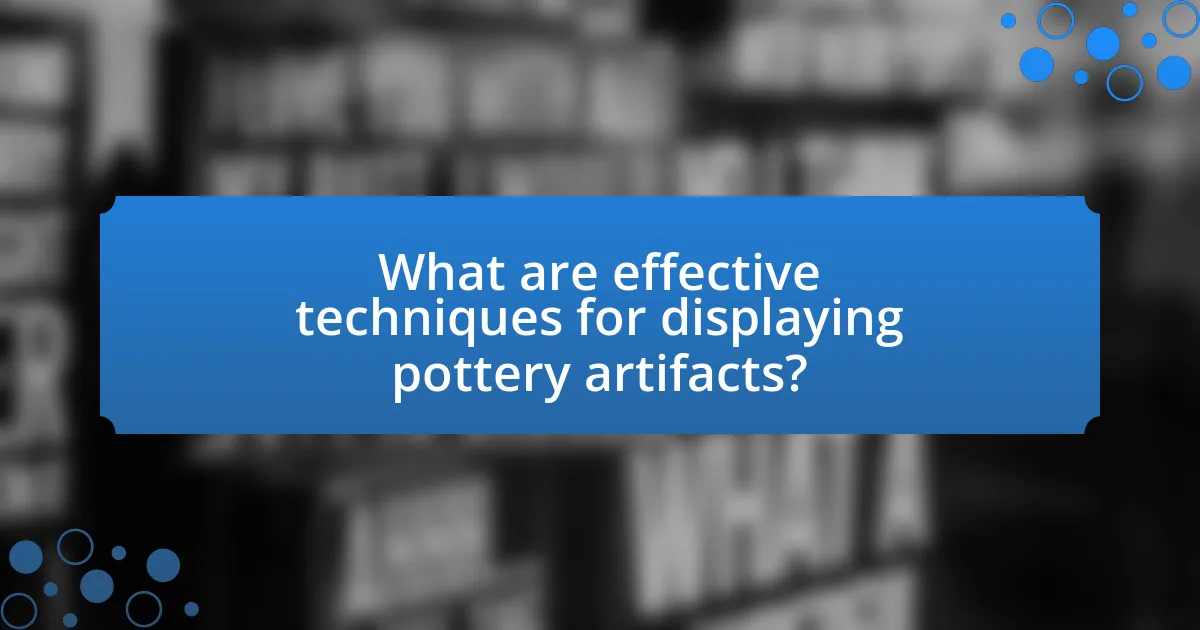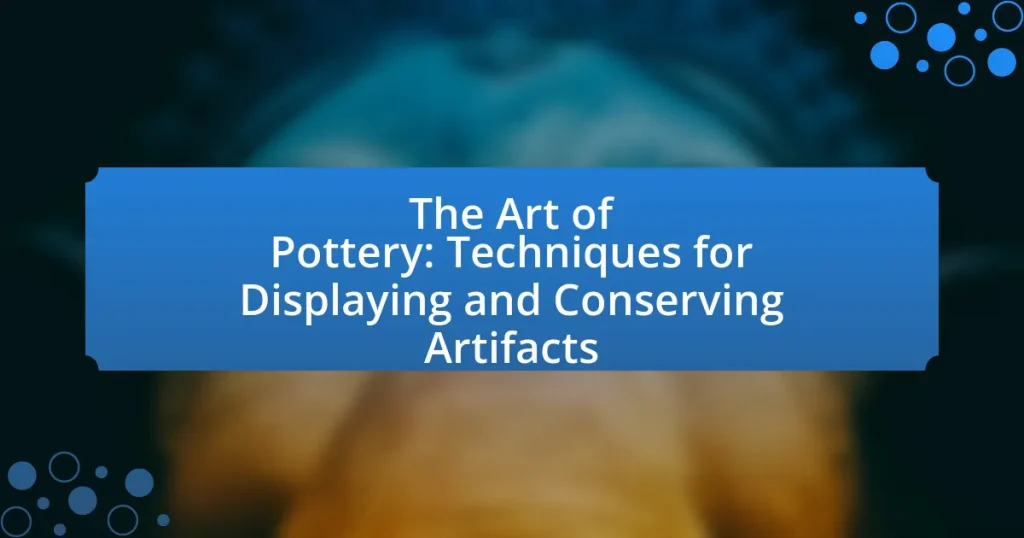The art of pottery encompasses the craft of shaping and firing clay to produce both functional and decorative objects, with a history dating back to at least 29,000 BCE. This article explores the evolution of pottery techniques, including hand-building, wheel-throwing, and glazing, while highlighting key historical periods that have influenced its development. It also examines how cultural factors shape pottery styles, the fundamental techniques used in the craft, and the artistic value of pottery as an expression of individuality. Additionally, the article discusses effective methods for displaying pottery artifacts, the importance of conservation practices, and best practices for long-term care to ensure the preservation of these cultural treasures.

What is the Art of Pottery?
The art of pottery is the craft of shaping and firing clay to create functional and decorative objects. This ancient practice dates back to at least 29,000 BCE, as evidenced by the discovery of the Venus of Dolní Věstonice, a ceramic figurine found in the Czech Republic. Pottery involves various techniques, including hand-building, wheel-throwing, and glazing, which enhance both the aesthetic and practical qualities of the finished pieces. The significance of pottery extends beyond mere utility; it serves as a cultural artifact that reflects the history and traditions of the societies that produce it.
How has pottery evolved throughout history?
Pottery has evolved significantly throughout history, transitioning from simple hand-formed vessels to complex, wheel-thrown creations and modern artistic expressions. Initially, ancient cultures, such as those in Mesopotamia around 3500 BCE, created pottery primarily for functional purposes, using coiling and pinching techniques. As societies advanced, the introduction of the potter’s wheel around 3000 BCE in Mesopotamia allowed for more uniform and intricate designs, enhancing both functionality and aesthetic appeal.
During the Classical period, pottery styles diversified, with the Greeks developing distinctive techniques like black-figure and red-figure painting, which showcased storytelling and artistry. The invention of glazes in the Han Dynasty (206 BCE – 220 CE) in China further transformed pottery, allowing for vibrant colors and improved durability.
In the modern era, pottery has continued to evolve, incorporating new materials and technologies, such as electric kilns and advanced glazing techniques, while also embracing contemporary artistic movements. This evolution reflects broader cultural shifts and technological advancements, demonstrating pottery’s enduring significance as both a practical craft and an art form.
What are the key historical periods in pottery development?
The key historical periods in pottery development include the Neolithic period, the Bronze Age, the Iron Age, and the Medieval period. During the Neolithic period (around 10,000 to 4,500 BCE), pottery began as a functional craft for storage and cooking, with early examples found in regions like the Near East. The Bronze Age (approximately 3,300 to 1,200 BCE) saw advancements in techniques and styles, with the introduction of wheel-thrown pottery and decorative glazing in cultures such as the Minoans and Mycenaeans. The Iron Age (around 1,200 to 600 BCE) continued to evolve pottery styles, with significant developments in Europe and Asia, including the use of iron-rich clays. Finally, the Medieval period (approximately 500 to 1500 CE) marked a time of increased trade and cultural exchange, leading to diverse pottery styles across Europe, Asia, and the Middle East, with notable examples like Islamic ceramics and European stoneware. Each period reflects technological advancements and cultural shifts that shaped the art of pottery.
How have cultural influences shaped pottery styles?
Cultural influences have significantly shaped pottery styles by dictating design elements, materials, and techniques used in various regions. For instance, the use of specific clay types and glazing methods can be traced back to local resources and cultural practices, such as the red clay pottery of the American Southwest, which reflects Native American traditions. Additionally, motifs and decorative styles often embody cultural narratives, as seen in the intricate patterns of Japanese Raku pottery, which are influenced by Zen Buddhism. Historical trade routes also facilitated the exchange of ideas and techniques, leading to hybrid styles, such as the fusion of Chinese porcelain aesthetics in European pottery during the 17th century. These examples illustrate how cultural contexts have directly influenced the evolution and diversity of pottery styles across different societies.
What are the fundamental techniques used in pottery?
The fundamental techniques used in pottery include hand-building, wheel-throwing, and glazing. Hand-building involves shaping clay by hand, often using methods like pinch, coil, or slab construction. Wheel-throwing utilizes a potter’s wheel to create symmetrical forms, allowing for precise shaping and uniformity. Glazing is the application of a glass-like coating to the surface of pottery, which enhances aesthetics and provides a protective layer. These techniques have been practiced for thousands of years, with evidence of hand-building dating back to 29,000 BCE and wheel-throwing emerging around 3,500 BCE in Mesopotamia, demonstrating their historical significance and evolution in pottery craftsmanship.
What are the different methods of shaping clay?
The different methods of shaping clay include hand-building, wheel-throwing, and molding. Hand-building involves techniques such as pinch pots, coil building, and slab construction, allowing for unique, organic forms. Wheel-throwing utilizes a potter’s wheel to create symmetrical shapes, which is a traditional method dating back thousands of years. Molding involves pressing clay into a pre-formed shape, often using plaster molds, to achieve consistent designs. Each method has distinct characteristics and applications in pottery, contributing to the versatility of clay as a medium.
How does glazing enhance pottery artifacts?
Glazing enhances pottery artifacts by providing a protective layer that increases durability and aesthetic appeal. The application of glaze creates a non-porous surface, which prevents moisture absorption and protects the pottery from environmental damage. Additionally, glazes can introduce vibrant colors and textures, enhancing the visual interest of the artifacts. Historical evidence shows that ancient civilizations, such as the Chinese during the Tang Dynasty, utilized glazing techniques to not only protect their pottery but also to create intricate designs that elevated the status of their artifacts in both functional and artistic contexts.
Why is pottery considered an art form?
Pottery is considered an art form because it combines creativity, skill, and aesthetic expression in the creation of functional and decorative objects. The process of shaping clay into unique forms allows artists to convey personal style and cultural significance, as seen in various historical pottery styles like Japanese Raku or ancient Greek ceramics. Additionally, pottery often involves intricate glazing and firing techniques that enhance visual appeal, further solidifying its status as an art form.
What elements contribute to the artistic value of pottery?
The artistic value of pottery is primarily contributed by form, decoration, technique, and cultural significance. The form refers to the shape and structure of the pottery, which can evoke aesthetic appreciation and functional use. Decoration includes the patterns, colors, and textures applied to the surface, enhancing visual appeal and conveying artistic intent. Technique encompasses the methods used in crafting pottery, such as wheel-throwing or hand-building, which can reflect the skill level and creativity of the potter. Cultural significance relates to the historical and social context of the pottery, often representing traditions, beliefs, and artistic movements. Each of these elements plays a crucial role in defining the overall artistic value of pottery, as evidenced by the diverse styles found in archaeological findings and contemporary art exhibitions.
How do artists express individuality through pottery?
Artists express individuality through pottery by utilizing unique techniques, materials, and designs that reflect their personal style and cultural influences. Each artist may choose specific clay types, glazing methods, and firing techniques that resonate with their artistic vision, allowing for a diverse range of textures, colors, and forms. For instance, the use of traditional Japanese Raku firing creates distinctive surface effects that embody the artist’s connection to heritage and personal expression. Additionally, the incorporation of symbolic motifs or personal narratives into the pottery further distinguishes an artist’s work, making it a representation of their identity and experiences.

What are effective techniques for displaying pottery artifacts?
Effective techniques for displaying pottery artifacts include using appropriate lighting, selecting suitable display cases, and ensuring proper spacing. Proper lighting enhances the visual appeal and highlights the details of the pottery, while display cases protect the artifacts from dust and damage. Additionally, maintaining adequate spacing between pieces prevents overcrowding, allowing viewers to appreciate each artifact individually. Research indicates that well-designed displays can increase visitor engagement and understanding of the artifacts’ cultural significance.
How can lighting impact the presentation of pottery?
Lighting significantly impacts the presentation of pottery by influencing how colors, textures, and shapes are perceived. Proper lighting can enhance the visual appeal of pottery, highlighting intricate details and creating depth through shadows. For instance, natural light can reveal the true colors and glazes of pottery, while artificial lighting can be adjusted to create specific moods or effects. Studies in art presentation have shown that directional lighting can accentuate the contours of ceramic pieces, making them more engaging to viewers.
What types of lighting are best for showcasing pottery?
Natural lighting and diffused artificial lighting are the best types of lighting for showcasing pottery. Natural light enhances the colors and textures of pottery without causing glare or distortion, making it ideal for display in well-lit areas. Diffused artificial lighting, such as LED lights with soft filters, minimizes harsh shadows and highlights the intricate details of the pottery. Studies have shown that proper lighting can significantly improve the visual appeal of ceramic artifacts, allowing viewers to appreciate their craftsmanship and artistry.
How does the placement of pottery affect viewer perception?
The placement of pottery significantly influences viewer perception by guiding attention and shaping emotional responses. Strategic positioning can enhance visibility and accessibility, allowing viewers to engage more deeply with the artwork. For instance, pottery displayed at eye level tends to attract more attention and encourages closer examination, as evidenced by studies showing that artworks positioned within the viewer’s line of sight are more likely to be appreciated (Hagtvedt & Brasel, 2016). Additionally, the arrangement of pottery in relation to other objects can create narratives or thematic connections, further impacting how viewers interpret the pieces. Thus, effective placement is crucial for maximizing the aesthetic and interpretive experience of pottery.
What display methods enhance the appreciation of pottery?
Display methods that enhance the appreciation of pottery include the use of proper lighting, elevated platforms, and contextual backgrounds. Proper lighting highlights the texture and color of pottery, making details more visible and enhancing visual appeal. Elevated platforms allow viewers to see pottery from multiple angles, promoting a deeper understanding of form and craftsmanship. Contextual backgrounds, such as natural materials or thematic displays, provide a narrative that connects the pottery to its cultural or historical significance, enriching the viewer’s experience. These methods are supported by museum practices that emphasize the importance of presentation in art appreciation.
What are the benefits of using pedestals or shelves for display?
Using pedestals or shelves for display enhances visibility and accessibility of artifacts. These display methods elevate items, allowing for better viewing angles and reducing the risk of damage from handling. Additionally, pedestals and shelves can be designed to complement the aesthetic of the displayed items, creating a cohesive presentation that draws attention. Research indicates that well-designed displays can increase visitor engagement and appreciation, as seen in museum studies where elevated displays led to a 30% increase in interaction with artifacts.
How can background choices influence the display of pottery?
Background choices significantly influence the display of pottery by affecting visual contrast, context, and viewer perception. For instance, a light-colored background can enhance the vibrancy of dark pottery glazes, making the piece stand out more prominently. Conversely, a dark background may create a dramatic effect, emphasizing the texture and details of the pottery. Research indicates that color theory plays a crucial role in art presentation; complementary colors can enhance the aesthetic appeal and draw attention to specific features of the pottery. Additionally, the background can provide contextual information, such as cultural or historical relevance, which enriches the viewer’s understanding and appreciation of the pottery.

How can pottery artifacts be conserved effectively?
Pottery artifacts can be conserved effectively through controlled environmental conditions, proper handling, and appropriate restoration techniques. Maintaining stable temperature and humidity levels is crucial, as fluctuations can lead to cracking or deterioration; for instance, a relative humidity of 45-55% is often recommended for ceramic preservation. Additionally, using archival-quality storage materials, such as acid-free boxes and silica gel packets, helps protect pottery from dust and moisture. Proper handling techniques, including wearing gloves and supporting the base of the artifacts, prevent physical damage. Restoration should be approached cautiously, utilizing reversible adhesives and materials to ensure that any repairs can be undone without harming the original artifact. These methods are supported by conservation guidelines from institutions like the American Institute for Conservation, which emphasize the importance of preventive care in preserving cultural heritage.
What are the common threats to pottery conservation?
Common threats to pottery conservation include environmental factors, physical damage, and biological deterioration. Environmental factors such as humidity, temperature fluctuations, and light exposure can lead to deterioration of pottery materials. Physical damage often occurs due to mishandling, accidental impacts, or inadequate storage conditions, which can result in cracks or breaks. Biological deterioration is caused by pests, mold, and bacteria that can compromise the integrity of pottery artifacts. These threats are well-documented in conservation literature, emphasizing the need for controlled environments and careful handling to preserve pottery effectively.
How does environmental control aid in preserving pottery?
Environmental control aids in preserving pottery by regulating temperature, humidity, and light exposure, which are critical factors in preventing deterioration. Maintaining stable temperature and humidity levels minimizes the risk of thermal shock and moisture-related damage, such as cracking or mold growth. For instance, a relative humidity level of around 45-55% is often recommended to prevent the clay from becoming too dry or too moist, which can lead to structural instability. Additionally, controlling light exposure, particularly ultraviolet light, helps prevent fading and degradation of pigments and glazes. Research indicates that proper environmental conditions can significantly extend the lifespan of pottery artifacts, ensuring their integrity for future generations.
What role does handling play in the conservation of pottery?
Handling plays a critical role in the conservation of pottery by minimizing physical damage and degradation during interaction. Proper handling techniques, such as using gloves and supporting the base, reduce the risk of chipping, cracking, or transferring oils and dirt from hands to the pottery surface. Research indicates that even minimal contact can lead to wear over time, emphasizing the importance of careful handling practices in preserving the integrity and longevity of ceramic artifacts.
What techniques are recommended for cleaning pottery artifacts?
Recommended techniques for cleaning pottery artifacts include using soft brushes, distilled water, and mild detergents. Soft brushes help remove surface dirt without damaging the pottery, while distilled water prevents mineral deposits that can occur with tap water. Mild detergents can be used sparingly to break down grease or grime, but it is essential to rinse thoroughly to avoid residue. These methods are widely accepted in conservation practices, ensuring the integrity of the artifacts is maintained while effectively cleaning them.
What materials should be avoided when cleaning pottery?
When cleaning pottery, abrasive materials such as steel wool, scouring pads, and harsh chemicals should be avoided. These materials can scratch the surface of the pottery, leading to irreversible damage and loss of aesthetic value. Additionally, bleach and ammonia can cause discoloration or deterioration of glazes and finishes. Using soft cloths and gentle, pH-balanced cleaners is recommended to preserve the integrity of the pottery.
How can one safely remove dirt and grime from pottery?
To safely remove dirt and grime from pottery, one should use a soft brush or cloth along with a mild soap solution. This method prevents scratching and damage to the pottery’s surface. The soft brush effectively loosens dirt without being abrasive, while the mild soap helps to break down grime. It is essential to rinse the pottery thoroughly with clean water after cleaning to remove any soap residue, which can cause further staining or damage. This approach is widely recommended by conservators and pottery experts to maintain the integrity of the artifacts.
What best practices should be followed for long-term pottery care?
To ensure long-term pottery care, it is essential to store pottery in a stable environment with controlled temperature and humidity. Pottery should be kept away from direct sunlight, which can cause fading and damage to glazes. Additionally, using soft cloths for cleaning prevents scratches, while avoiding harsh chemicals preserves the integrity of the materials. Regular inspections for cracks or chips allow for timely repairs, which can prevent further deterioration. These practices are supported by conservation guidelines from institutions like the American Institute for Conservation, which emphasize the importance of environmental stability and gentle handling in preserving ceramic artifacts.
How can regular maintenance extend the life of pottery artifacts?
Regular maintenance can significantly extend the life of pottery artifacts by preventing deterioration and damage. Routine cleaning, careful handling, and appropriate storage conditions help to mitigate the effects of environmental factors such as humidity, temperature fluctuations, and dust accumulation. For instance, using soft brushes or microfiber cloths to remove dust prevents scratches and surface wear, while controlling humidity levels can prevent cracking and warping. Studies have shown that artifacts maintained in stable environments can last for centuries, highlighting the importance of consistent care in preserving their integrity and aesthetic value.
What are the signs that pottery needs professional conservation?
Pottery needs professional conservation when it exhibits signs of physical damage, such as cracks, chips, or breaks. These issues can compromise the structural integrity and aesthetic value of the piece. Additionally, discoloration, flaking, or loss of glaze indicates deterioration that may require expert intervention. Environmental factors like excessive humidity or temperature fluctuations can also lead to damage, necessitating professional assessment and care.


